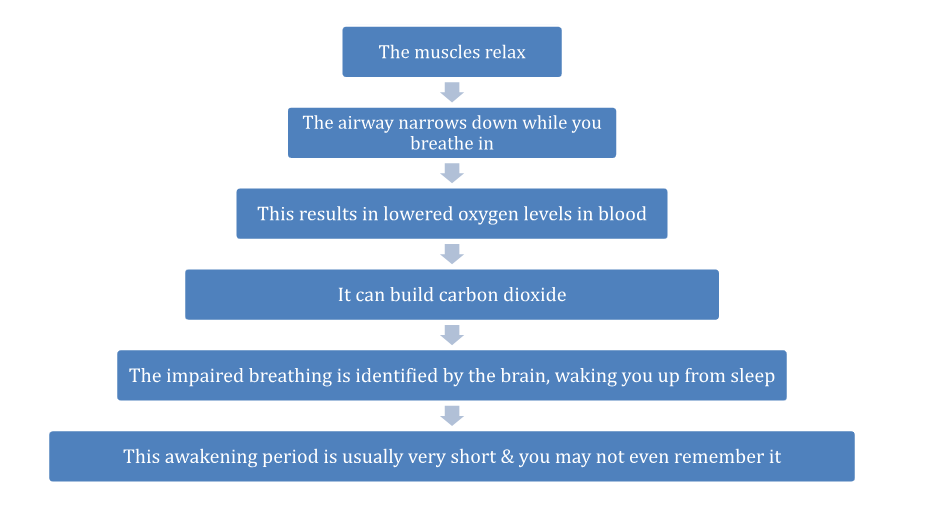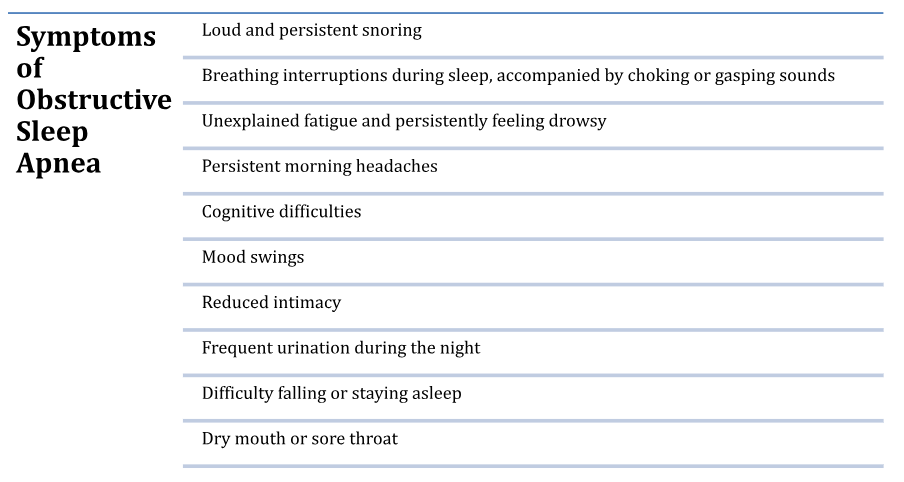
Obstructive Sleep Apnea (OSA) is a sleep condition characterised by recurrent interruptions in breathing during sleep. This blog navigates through the key aspects of OSA, aiming to help you understand, identify, and manage this condition effectively.
Synopsis
What is Obstructive Sleep Apnea?
The over-relaxation of the back muscles of the throat obstructs proper breathing. This results in obstructive sleep apnea. It is the more common form of Sleep Apnea among the 3 major types. Below, we have explained the process of this occurrence.

Risk Factors of Obstructive Sleep Apnea
The common risk factors attributed to Sleep Apnea are as follows.
- Anatomical Factors - Structural abnormalities can increase the likelihood of airway collapse. It especially includes a narrow throat or enlarged tonsils.
- Obesity - Excessive weight can contribute to the compression of the airway. People with a thick neck circumference are more prone to develop OSA.
- Age and Gender - OSA becomes more common as individuals age, and men are generally at a higher risk. The risk for women increases, particularly after menopause.
- Family History and Genetics - A family history of sleep apnea may elevate the risk. It suggests a genetic predisposition to the condition.
- Smoking and Alcohol Use - Smoking irritates the airway. Alcohol or sedative use relaxes our muscles. Both contribute to airway collapse and heightened OSA risk.
- Medical Conditions - Risky health issues include hypertension, diabetes, hormonal disorders, and asthma.
- Use of Sedatives and Muscle Relaxants - Certain medications relax the throat muscles. They potentially exacerbate airway obstruction during sleep.
- Position During Sleep - Sleeping on your back may increase the risk of airway collapse. Positional factors can play a role in OSA severity.
- Chronic Nasal Congestion - Chronic sinus issues contribute to breathing difficulties and increase the risk of OSA.
Recognising these risk factors is essential for early identification. You can take the help of a top pulmonologist in Bangalore to treat the condition.
What Are the Symptoms of Obstructive Sleep Apnea?

Identification of these Obstructive sleep apnea symptoms is essential for accurate medical intervention.
Diagnosing Obstructive Sleep Apnea
Sleep apnea diagnosis is made using the following approaches:
-
Sleep Studies - Polysomnography (PSG) is the primary diagnostic test for OSA. It is conducted in a sleep centre. This approach monitors brain activity, eye movement, heart rate, respiratory effort, airflow, and oxygen levels during sleep.
-
Home Sleep Apnea Testing (HSAT) - In certain cases, portable monitoring devices may be used for home-based sleep studies. It is a convenient alternative.
-
Epworth Sleepiness Scale - The Epworth Sleepiness Scale consists of a questionnaire that helps quantify daytime sleepiness and assesses its impact on your daily activities.
Consult an experienced pulmonologist if you notice persistent symptoms of OSA.
Treatment for Obstructive Sleep Apnea
The treatment routes to manage OSA are as follows:
-
Continuous Positive Airway Pressure (CPAP)
Continuous positive airway pressure is a positive airway pressure (PAP) therapy device used to treat sleep apnea. It involves wearing a mask over the nose and mouth during sleep. Its continuous stream of air keeps the airway open.
-
Bi-Level Positive Airway Pressure (BiPAP)
Bi-Level Positive Airway Pressure is another type of non-invasive positive airway pressure (PAP) therapy used to treat sleep apnea. Unlike CPAP, BiPAP allows for varying air pressure levels which can be adjusted to the patient's breathing patterns. This is often prescribed if one cannot tolerate CPAP which delivers constant air pressure throughout both inhalation and exhalation.
-
Oral Appliances
Dental devices or mandibular advancement devices can reposition the tongue and lower jaw. This helps keep the airway open. These are particularly beneficial for mild to moderate OSA treatment.
-
Lifestyle Modifications
Maintaining a healthy weight with proper diet and exercise can significantly reduce the severity of OSA.
-
Positional Therapy
Your doctor may suggest you follow certain positions to minimise airway obstruction.
-
Surgery
Doctors may consider a surgical approach when other treatments fail. The procedures may include uvulopalatopharyngoplasty (UPPP), Tracheostomy, genioglossus advancement (GA), or maxillomandibular advancement (MMA).
-
Positional Therapy
This involves sleeping on your side or using pillows to prop yourself up at night. This can help to prevent your airway from collapsing.
-
Nerve Stimulation Therapy
This therapy uses a device implanted in your chest to stimulate the nerve (hypoglossal nerve) that controls your tongue. This can help to keep your airway open while you sleep.
Lifestyle changes
- Weight Loss: Even a small amount of weight loss can improve OSA symptoms in obese and overweight patients. Exercise regularly to maintain an ideal weight.
- Avoiding Alcohol and Sedatives: Avoid taking caffeine and alcohol, especially before bed. These substances can relax the muscles in your throat and make OSA worse.
- Sleeping Position: Sleeping on your back can worsen OSA symptoms; however, sleeping on your side can help keep your airway open.
- Quitting Smoking: Smoking can irritate the lining of your throat and worsen your condition.
People with obstructive sleep apnea may experience mid-sleep awakening 5 to 30 times throughout the night. It can not only deteriorate your quality of life but also lead to many other serious health issues, such as cardiovascular problems. If you are suffering from such issues, please consult a pulmonologist in Bangalore for a precise diagnosis and treatment.
FAQ's
The following lifestyle changes can help in managing OSA:
- Maintaining a healthy weight
- Avoiding alcohol consumption
- Quitting smoking
Lifestyle changes and positional therapy may alleviate mild obstructive sleep apnea. However, moderate to severe cases often require medical intervention.
Yes, obstructive sleep apnea can occur in children. Most commonly, the reasons are enlarged tonsils and adenoids.



















 4 Min Read
4 Min Read













